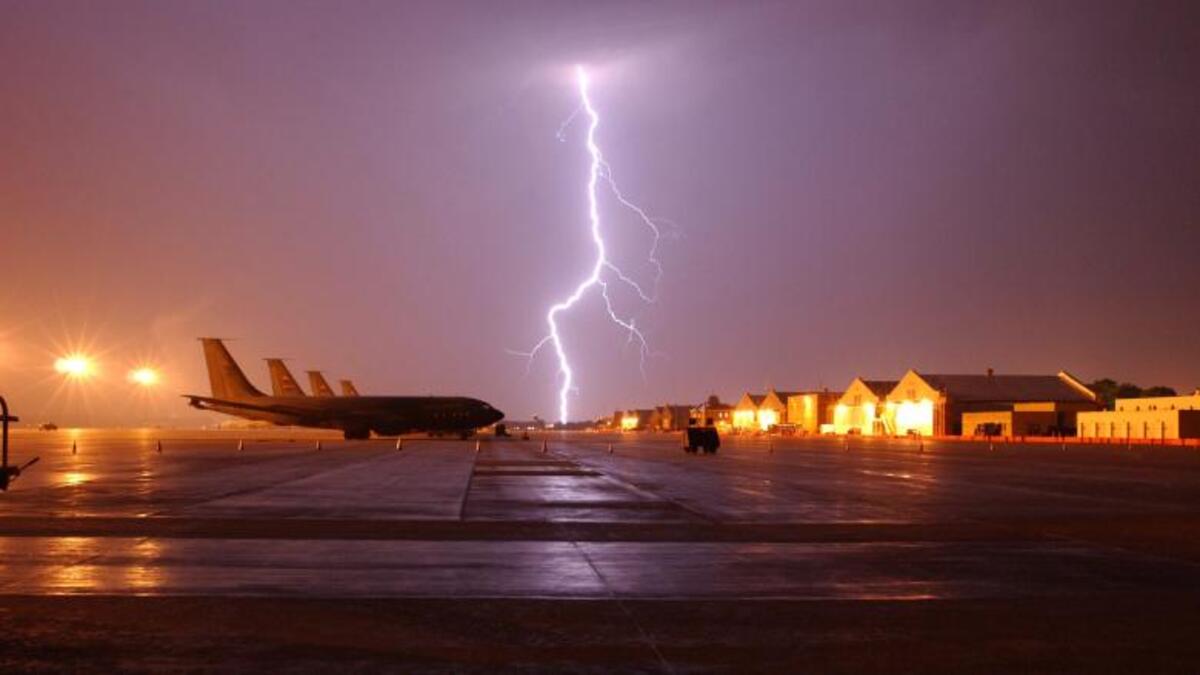What does it feel like when a plane is struck by lightning? Let’s find out, shall we?
Imagine you’re flying peacefully at cruising altitude, maybe sipping your ginger ale, when suddenly, flash! A burst of light outside the window. Was that… lightning? Did the plane just get hit?!
Relax. While it might look like Zeus just declared war on your aircraft, planes are actually designed to take a lightning strike like a champ.
Let’s look into what really happens when a plane is struck by lightning, and why it’s nowhere near as scary as it sounds.
How often do planes get struck by lightning?
Commercial aircraft get struck by lightning approximately once every 1,000 flight hours. That might sound rare until you realize that’s roughly once or twice a year for most jets.
The truth? Most of the time, neither passengers nor crew even realize it happened. You’re more likely to be disturbed by a crying baby than a bolt of lightning.
So What Actually Happens During a Strike?
Here’s the breakdown of the process:
1. The Bolt Hits (Usually the Nose)
Lightning typically strikes the front of the plane, often the nose or the wingtip. That’s where the aircraft first meets the electric charge as it slices through the stormy skies.
2. Electricity Travels Along the Fuselage
The plane acts like a giant Faraday cage, a protective shell that allows electrical energy to pass along its outer skin without affecting the interior. In other words, it’s like a lightning rod with wings.
3. The Current Exits (Usually the Tail)
Once the energy has danced along the aircraft’s surface, it exits through the tail or another extremity. Like a guest at a party who grabs a drink, says nothing, and dips out the back door, lightning doesn’t linger.
Is It Dangerous? (Spoiler: Not Really)
It’s a fair question. After all, lightning packs millions of volts. So is it dangerous?
To the aircraft: Modern airliners are built with composite materials and conductive mesh to disperse electrical energy safely. Engineers spend years testing how planes hold up under simulated strikes. The design ensures that the essential systems like avionics, flight controls, and fuel tanks, are shielded and grounded.
To the passengers and crew: You’re completely safe inside. The plane absorbs and redirects the current. Your biggest risk? Spilling your coffee if you jump at the flash.
Minor Damage Can Happen (But It’s Rarely Serious)
While most lightning strikes leave little to no evidence. In almost all cases, the plane continues the flight normally and lands safely. Maintenance crews then inspect and, if necessary, repair the aircraft before it flies again.
Some superficial signs of a lightening strike are:
- Scorch marks or minor burn spots near entry/exit points
- Slight electrical system disruptions (rare)
- Tiny punctures or delamination of composite materials
Fun Fact: Sometimes the Plane Triggers the Lightning
Yeah, planes are just out here starting their own electrical drama.
When flying through a heavily charged atmosphere, an aircraft can trigger a lightning strike by bridging the electrical gap between different areas of the cloud.
It’s just physics, nothing personal.
What Do Pilots Do When Lightning Strikes?
Pilots are trained to handle weather-related phenomena. When a strike occurs, they’ll:
- Run quick checks on instruments and electrical systems
- Communicate with air traffic control
- Log the incident for post-flight inspection
In most cases, no action beyond monitoring is necessary. They’ll continue on the route.
Can Lightning Cause a Crash?
Here’s the golden nugget: There hasn’t been a lightning-related plane crash on a commercial airliner since 1967.
That’s over five decades of technological advancements and zero fatal lightning-related accidents in commercial aviation.
So unless you’re flying in a time-traveling DC-9 from the 60s, you’ve got nothing to worry about.
How is a plane protected from lightning strikes
- Conductive Exteriors: Aircraft are made from aluminum or have conductive mesh embedded in composite materials.
- Shielded Avionics: Sensitive instruments are isolated from electromagnetic surges.
- Bonding Straps: These connect all parts of the plane to create a single conductive unit, helping the energy flow along a safe path.
- Static Wicks: Located on wingtips and tails, they discharge static electricity to prevent build-up.
What Happens After the Flight?
Once on the ground, the aircraft undergoes a post-lightning inspection by trained maintenance crews. If repairs are needed, they’re handled promptly. Safety always comes first. This includes:
- Checking the strike entry/exit points
- Testing avionics and electrical systems
- Verifying fuel tanks and hydraulic systems are uncompromised
Can Lightning Hit the Same Plane Twice?
Not only can it, it does. Some aircraft have been struck multiple times in their lifespan.
Unlike unlucky lottery tickets, lightning doesn’t care about past winners. If the atmosphere is charged, your plane might just be the tallest, fastest-moving conductor in the sky.
Final Thoughts: Don’t Sweat the Spark
Next time you see a lightning flash from your window seat, don’t panic. Remember:
- Planes are built to take it
- Pilots are trained for it
- Maintenance teams are prepared for it
And let’s be honest, freaking out is probably more dangerous than the strike itself. So sit back, enjoy your flight and marvel at the engineering marvel you’re flying in.

